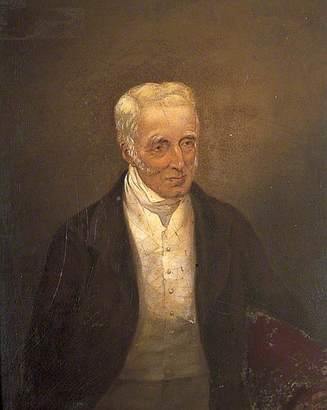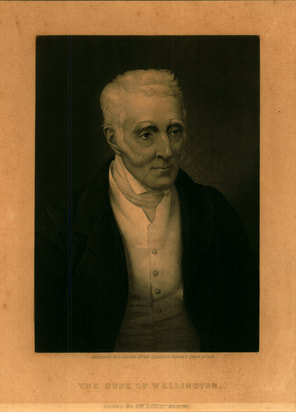Abraham Solomon's Portrait of Wellington Identified
by Roberto C. Ferrari, with contributing text by Geoffrey Batchen
Finding and identifying missing paintings by Simeon, Abraham, and Rebecca Solomon has proven to be one of the more exciting aspects of the Simeon Solomon Research Archive for Carolyn and me. The latest is a good example, and demonstrates some of the unusual ways these paintings often are unearthed.
A few years ago, Geoffrey Batchen (Professor of Art History, Victoria University, Wellington, New Zealand) told me that, in conducting research on the daguerreotype photographer Antoine Claudet, he had come across a reference noting that Claudet’s daguerreotype of the Duke of Wellington had been used by Abraham Solomon to paint his portrait, which was then used to make engravings. With the help of Claudet specialist Karen Hellman (Assistant Curator, J. Paul Getty Museum, Los Angeles), the original daguerreotype was traced. However, the Solomon painting was missing. The recent release of a digital image of the painting (located at Walmer Castle in Kent, England) on the BBC’s Your Paintings module on the Internet helped bring all of this research full circle. Until now, the artist of the portrait was unknown, but we can assert that this portrait of the Duke of Wellington is in fact by Abraham Solomon. Because Solomon was only about twenty years of age when he painted it, and had only begun submitting works to exhibitions in 1840, what remains a mystery is why he of all artists was chosen to paint this picture based on the daguerreotype? Although this may have been Solomon's first venture in commercial portrait painting from daguerreotypes, a recent discovery by Carolyn shows that this wasn't the only time he did this. According to the Birmingham Gazette (1 Jan 1849), prints by William Holl of the singer Jenny Lind were made from her portrait painted by Solomon based on a daguerreotype by William Edward Kilburn from Queen Victoria's collection.
A few years ago, Geoffrey Batchen (Professor of Art History, Victoria University, Wellington, New Zealand) told me that, in conducting research on the daguerreotype photographer Antoine Claudet, he had come across a reference noting that Claudet’s daguerreotype of the Duke of Wellington had been used by Abraham Solomon to paint his portrait, which was then used to make engravings. With the help of Claudet specialist Karen Hellman (Assistant Curator, J. Paul Getty Museum, Los Angeles), the original daguerreotype was traced. However, the Solomon painting was missing. The recent release of a digital image of the painting (located at Walmer Castle in Kent, England) on the BBC’s Your Paintings module on the Internet helped bring all of this research full circle. Until now, the artist of the portrait was unknown, but we can assert that this portrait of the Duke of Wellington is in fact by Abraham Solomon. Because Solomon was only about twenty years of age when he painted it, and had only begun submitting works to exhibitions in 1840, what remains a mystery is why he of all artists was chosen to paint this picture based on the daguerreotype? Although this may have been Solomon's first venture in commercial portrait painting from daguerreotypes, a recent discovery by Carolyn shows that this wasn't the only time he did this. According to the Birmingham Gazette (1 Jan 1849), prints by William Holl of the singer Jenny Lind were made from her portrait painted by Solomon based on a daguerreotype by William Edward Kilburn from Queen Victoria's collection.
The following text is an extract from Batchen’s forthcoming essay “Beauties and Deformities Alike: Beard, Claudet, and the Business of Photography,” in Modern Times: Richard Beard, Antoine Claudet, and the Invention of Commercial Photography (London; New Haven: Yale University Press, 2013).
The Times reported on May 22, 1845 that Claudet had taken daguerreotype portraits of the Duke of Wellington on his birthday, May 1, 1844, at the Adelaide Gallery studio.1 Interestingly, a few months later Claudet's long-term assistant, Edward J. Pickering, claimed he was the one who had actually taken the portraits.2 One of these images then went through various permutations. Having been bought by the publisher James Watson, the original daguerreotype (Claudet also seems to have made a copy daguerreotype of this original, and it was perhaps this that he exhibited at the Manchester Art Treasures exhibition in 1857) was lent to the painter Abraham Solomon, who used it to produce an enlarged portrait of the Duke. Both this painting and the daguerreotype were then lent to Henry Thomas Ryall, who used them to make a steel engraving. According to the Times, "the engraving has been principally made from the daguerreotype portrait, the work of Mr Solomon being used to correct those defects which of necessity arise in all daguerreotype portraits."3 Supposedly "a simple result of the union of science with art," the resulting print was described by the reporter for the Times as "a likeness surpassing in fidelity both the original daguerreotype and the painted copy; in short, a likeness so true to nature and so complete a translation of the features, character, and very look of the illustrious Duke, that nothing but the reflection of the face of his Grace in a mirror can surpass it."4
According to a story in the Illustrated London News, published a few years later on November 13, 1852, the Duke himself was not particularly impressed by Ryall's print, perhaps because it was indeed "so true to nature": "He looked at it for a moment, shook his head, and, with a half smile and half frown of recognition, muttered 'Very old! Hum!' and turned away in thought."5 Nor was this the end of Claudet's Wellington progeny. In this same year of 1852, John Sartain used a mixture of mezzotint, etching and aquatint to produce another engraved version of Claudet's daguerreotype portrait of the Duke, with this image accompanying an obituary for Wellington that appeared in the Eclectic Magazine. It was reproduced again in the same magazine a few years later, in 1860.6 Subsequently, a carte-de-visite copy of Ryall's print, transferred into sepia by its albumen photograph, was also issued by an unnamed studio. By all these means, Claudet's portrait was able to circulate well beyond the few people who might have been able to see that first daguerreotype.
Notes
1. Unknown, 'Claudet's Portrait of the Duke of Wellington,' The Times (May 22, 1845), 7.
2. Reported in the Glasgow Examiner (January 25, 1845), 3c, as quoted in Heathcote, A Faithful Likeness, 39.
3. Unknown, 'Claudet's Portrait of the Duke of Wellington,' The Times (May 22, 1845), 7.
4. ibid.
5. Unknown, 'Statues, Portraits and Memorials of Wellington,' Illustrated London News (November 13, 1852), 416. Thanks to Roberto C. Ferrari for sharing this research.
6. See 'Arthur Wellesley, Duke of Wellington, with a portrait,' The Eclectic Magazine of Foreign Literature, 27: 3 (November 1852), 362, and 'The Duke of Wellington,' The Eclectic Magazine of Foreign Literature, 49: 2 (February 1860), 286.
The Times reported on May 22, 1845 that Claudet had taken daguerreotype portraits of the Duke of Wellington on his birthday, May 1, 1844, at the Adelaide Gallery studio.1 Interestingly, a few months later Claudet's long-term assistant, Edward J. Pickering, claimed he was the one who had actually taken the portraits.2 One of these images then went through various permutations. Having been bought by the publisher James Watson, the original daguerreotype (Claudet also seems to have made a copy daguerreotype of this original, and it was perhaps this that he exhibited at the Manchester Art Treasures exhibition in 1857) was lent to the painter Abraham Solomon, who used it to produce an enlarged portrait of the Duke. Both this painting and the daguerreotype were then lent to Henry Thomas Ryall, who used them to make a steel engraving. According to the Times, "the engraving has been principally made from the daguerreotype portrait, the work of Mr Solomon being used to correct those defects which of necessity arise in all daguerreotype portraits."3 Supposedly "a simple result of the union of science with art," the resulting print was described by the reporter for the Times as "a likeness surpassing in fidelity both the original daguerreotype and the painted copy; in short, a likeness so true to nature and so complete a translation of the features, character, and very look of the illustrious Duke, that nothing but the reflection of the face of his Grace in a mirror can surpass it."4
According to a story in the Illustrated London News, published a few years later on November 13, 1852, the Duke himself was not particularly impressed by Ryall's print, perhaps because it was indeed "so true to nature": "He looked at it for a moment, shook his head, and, with a half smile and half frown of recognition, muttered 'Very old! Hum!' and turned away in thought."5 Nor was this the end of Claudet's Wellington progeny. In this same year of 1852, John Sartain used a mixture of mezzotint, etching and aquatint to produce another engraved version of Claudet's daguerreotype portrait of the Duke, with this image accompanying an obituary for Wellington that appeared in the Eclectic Magazine. It was reproduced again in the same magazine a few years later, in 1860.6 Subsequently, a carte-de-visite copy of Ryall's print, transferred into sepia by its albumen photograph, was also issued by an unnamed studio. By all these means, Claudet's portrait was able to circulate well beyond the few people who might have been able to see that first daguerreotype.
Notes
1. Unknown, 'Claudet's Portrait of the Duke of Wellington,' The Times (May 22, 1845), 7.
2. Reported in the Glasgow Examiner (January 25, 1845), 3c, as quoted in Heathcote, A Faithful Likeness, 39.
3. Unknown, 'Claudet's Portrait of the Duke of Wellington,' The Times (May 22, 1845), 7.
4. ibid.
5. Unknown, 'Statues, Portraits and Memorials of Wellington,' Illustrated London News (November 13, 1852), 416. Thanks to Roberto C. Ferrari for sharing this research.
6. See 'Arthur Wellesley, Duke of Wellington, with a portrait,' The Eclectic Magazine of Foreign Literature, 27: 3 (November 1852), 362, and 'The Duke of Wellington,' The Eclectic Magazine of Foreign Literature, 49: 2 (February 1860), 286.
|
This website was created by Dr Carolyn Conroy and Dr Roberto C. Ferrari, and is copyrighted by law. Images were reproduced with either the direct permission of the owners or via Creative Commons fair use - distribution rights for these works rests with the individuals who own the original work of art. All secondary source material reproduced here is protected by copyright with the author or publisher of the original source. The only exception to this rule are the items made available that are in the public domain. The rules of fair use apply if you wish to use any information from this site for non-profit educational purposes. See Citing this Site.
Simeon Solomon Research Archive ©2000 - 2024 |

